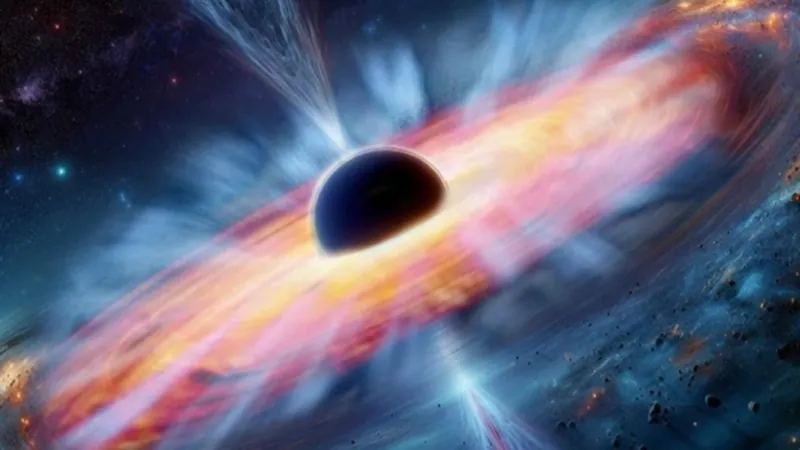
Supermassive Black Holes: Breaking the Rules of Physics to Become Cosmic Giants!
2024-11-20
Author: Jia
Introduction
In a groundbreaking discovery, scientists have unearthed compelling evidence that supermassive black holes, which formed less than a billion years after the Big Bang, may have challenged the foundational laws of physics to attain their incredible sizes. This revelation could potentially unravel one of the most enigmatic puzzles in astrophysics: How did these colossal entities grow so rapidly in the nascent universe?
The Nature of Supermassive Black Holes
Supermassive black holes, boasting masses millions to billions of times that of our Sun, reside at the centers of nearly all large galaxies. Traditionally, research suggests these giants expand through mergers with other black holes and by consuming surrounding matter. When these black holes feast on nearby material, they create brilliant accretion disks—flattened clouds of gas—that emit intense radiation, producing what we call quasars. These celestial phenomena can shine with a luminosity surpassing that of all the stars in their host galaxies combined!
The Growth Mystery
However, conventional wisdom holds that the processes necessary for black holes to achieve supermassive status typically require more than a billion years. This creates a significant conundrum as astronomers observe supermassive black hole-powered quasars existing merely 500 million years post-Big Bang, raising serious questions regarding the growth dynamics of these cosmic giants.
A New Approach to Understanding Supermassive Black Holes
To address this mystery, an international team of researchers utilized the XMM-Newton and Chandra space telescopes, focusing on 21 of the earliest quasars detected in X-ray light. Remarkably, they discovered evidence suggesting that these supermassive black holes had the capacity to grow rapidly through intense feeding bursts, a process known as "accretion," thereby achieving monstrous sizes during a critical phase in the universe's evolution termed the "cosmic dawn."
Significance of the Findings
Our findings indicate that the supermassive black holes powering the first quasars in the universe's initial billion years may have gathered mass at an astonishing rate, seemingly defying the established limits of physics,” remarked Alessia Tortosa, lead researcher from the Italian National Institute for Astrophysics (INAF).
The Eddington Limit
This frenetic feeding frenzy raises eyebrows due to the "Eddington limit," a theoretical boundary that states that any body in space accumulating matter has a maximum luminosity it can achieve. If a black hole feeds too rapidly, radiation pressure from the emitted light could counteract gravitational attraction, halting the supply of infalling material.
Super-Eddington Accretion
Through their analysis, the research team proposed that supermassive black holes might enter a phase of "super-Eddington accretion." They uncovered an intriguing correlation between X-ray spectrum shapes emitted by quasars and the speeds of powerful winds of matter expelled from them—these winds can travel at thousands of miles per second. The data indicated that quasars showcasing low-energy X-ray emissions, suggesting a cooler gas environment, exhibited faster-moving winds, while high-energy X-ray sources appeared to have slower winds.
Interconnection Between X-ray Emissions and Quasar Winds
This complex interrelationship provides insight into the mechanisms governing mass accretion in supermassive black holes and supports the hypothesis of an extraordinary feeding phase that could explain their astonishing existence in the early universe, occurring before the cosmos reached a billion years old.
Conclusion
The interconnection between X-ray emissions and quasar winds is pivotal in comprehending how such massive black holes formed in record time, offering a valuable piece of the puzzle in solving one of modern astrophysics' most significant mysteries. The XMM-Newton data analyzed in this study was gathered from 2021 to 2023 for the Multi-Year XMM-Newton Heritage Programme and the HYPERION project, which seeks to study extraordinarily luminous quasars from the universe's formative era. Lead researcher Luca Zappacosta described their objectives, emphasizing the meticulous selection of quasars for observation and a comprehensive examination of their X-ray properties. As researchers continue to explore the enigmatic origins and development of supermassive black holes, the findings herald an exciting future for astrophysics, driving our understanding of the universe to unprecedented heights! What other secrets lie hidden within the depths of space? Stay tuned!



 Brasil (PT)
Brasil (PT)
 Canada (EN)
Canada (EN)
 Chile (ES)
Chile (ES)
 España (ES)
España (ES)
 France (FR)
France (FR)
 Hong Kong (EN)
Hong Kong (EN)
 Italia (IT)
Italia (IT)
 日本 (JA)
日本 (JA)
 Magyarország (HU)
Magyarország (HU)
 Norge (NO)
Norge (NO)
 Polska (PL)
Polska (PL)
 Schweiz (DE)
Schweiz (DE)
 Singapore (EN)
Singapore (EN)
 Sverige (SV)
Sverige (SV)
 Suomi (FI)
Suomi (FI)
 Türkiye (TR)
Türkiye (TR)